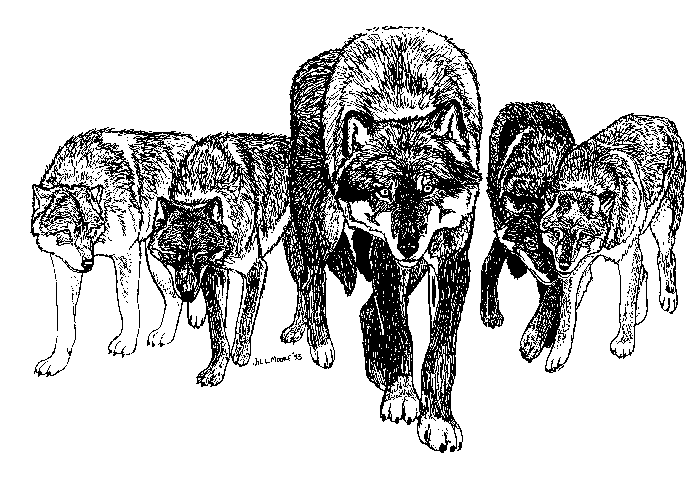

The wolf has been classified as "endangered" in the U.S. under the Endangered Species Act (ESA) since 1973. The exception to that is Alaska, where it is not listed, and Minnesota, where the wolf has been classified as "threatened" since 1978. The numerical goals required for the status of wolves to be reclassified from "endangered" to "threatened" have been achieved in the western Great Lakes region. The US Fish and Wildlife Service is in the process of determining how to respond to this growth in wolf population.
The recovery plan for the Eastern region calls for an additional population of viable wolves to be established outside of Minnesota, in the wolf's former range. The approximately 250 wolves in Wisconsin and Michigan's Upper Peninsula fulfill this part of the plan. There are several options the USFWS could chose at this time. It could prepare to remove the wolf from the protection of the ESA (delist) since the wolf will soon reach delist levels, it could reclassify the wolf from "endangered" to "threatened," or it could wait until the wolf actually reaches delist levels before taking any action.
According to Paul Burke, USFWS biologist, a decision is not complete on exactly what will happen. But he did say that the USFWS thinks that reclassification of the wolf from endangered to threatened in a larger region than just Minnesota would be a good transition in the movement towards delisting. At this point the USFWS is leaning towards reclassifying only in the states with wolf populations, Wisconsin and Michigan.
The ESA does not require a species be moved from endangered to threatened before delisting. But since there is some opposition to delisting, the extra step could give time to the process of determining how to best manage wolves in the future and possibly diffuse the fears of the opposition. The FWS anticipates the numerical goals for delisting the wolf in this region to be met in the next couple of years.
When a species protected by the ESA is reclassified to the threatened status, it maintains its legal protection under the act. However, the "threatened" classification has room for exceptions under Section 4, Paragraph D, which allows for the "taking" of animals. The rule requires that the taking (which means moving or more often killing the animal) is consistent with the purpose of the act, which is species recovery. And it requires that government agents do the taking, so citizens cannot begin to hunt wolves or kill wolves on their property.
Under this classification wolves in Wisconsin and Michigan would be legally "taken" when FWS and their partners Animal Damage Control (recently renamed Wildlife Services) decide that it would be in the population's best interest to do so. In most cases this exception is used to kill wolves involved in livestock depredation. The theory is that if the wolves doing the depredation are killed, there will be greater support from citizens for overall recovery. Thus the wolf population's protection is enhanced in the long term by the killing of some individuals.
There is disagreement on whether this type of "taking" is administered correctly in Minnesota, where wolves are already classed as threatened. Critics say that too many wolves are killed, that this rule is not used selectively enough. Others say that there should be no killing of wolves until the population is larger. (For more on this, see Let's Not Rush into Anything...)
Another component of this issue is whether reclassification lowers the priority of wolf recovery and thereby reduces the program's funding. Are we ready for wolves to be placed on the "back burner?" USFWS is aware that reducing funding to species as they move through the recovery process could impede progress, and it is working to address this issue, Burke said.
By March of 1998, this spring, it is likely that there will be a Notice of Intent to reclassify the wolf printed in the Federal Register, which will be followed by a comment period during which the public can express opinions on this action.
The state of Minnesota is beginning to work toward a new wolf management plan. Public hearings will be held this winter to collect citizen input on the management plan. The state will not be asked to take over management of the wolves until they are delisted.
The next step, removing wolves from the protection of the ESA completely, will
"likely" follow reclassification by a year or more, Burke said. This delisting process is
more complex than reclassification. Besides showing that recovery goals have been met, it must
be shown that under the new management plans the wolf population is not likely to need the
protection of the ESA in the foreseeable future.

This means that delisting cannot happen before the state has laid out in detail how it plans to deal with its wolves. Burke said that it is likely that the FWS will monitor how the reclassification goes, and use this information to help determine how and when to delist.
Burke said that he is "pleased we are recognizing recovery." He believes that in order for the ESA to receive continued support from the public, the government must prove that a species can go from full protection under the ESA to delisting. People need to be reassured there is an end to the process, he said. And in order to protect other species along with wolves in the future, the ESA needs broad public support.
It is reprinted from the Summer 1997 Issue of WOLF! Magazine. This unique and comprehensive magazine is not supported by advertising, but by subscriptions. Please help keep this much needed resource alive!
 |